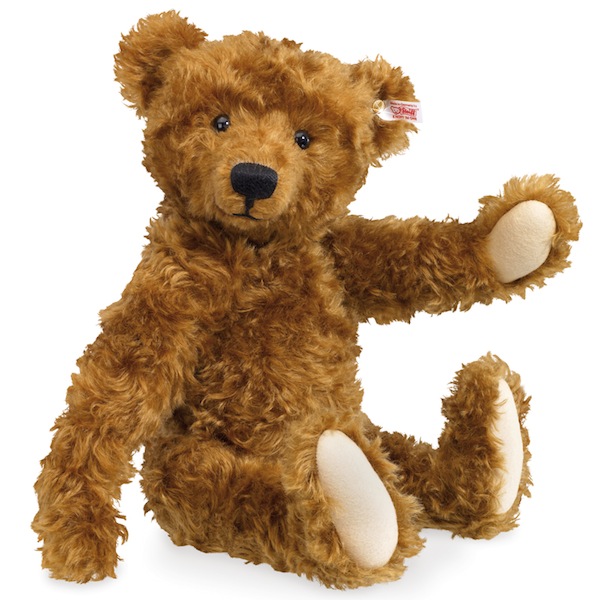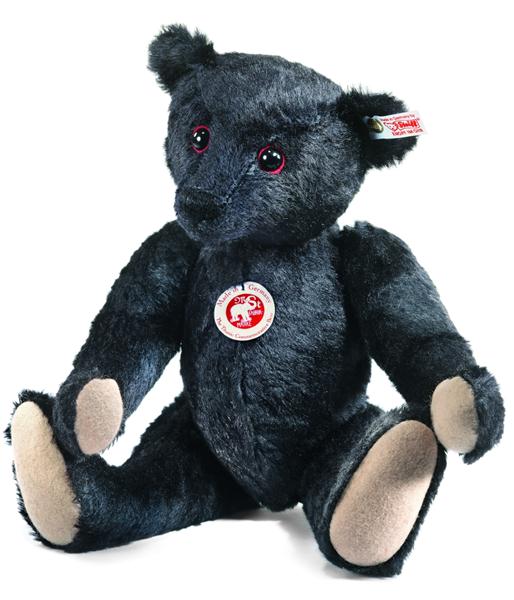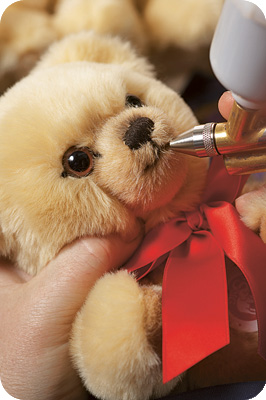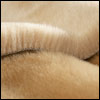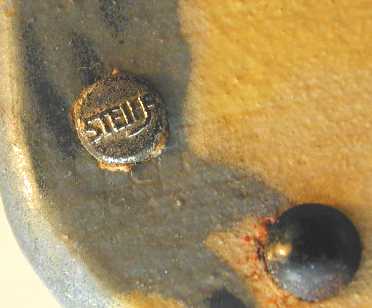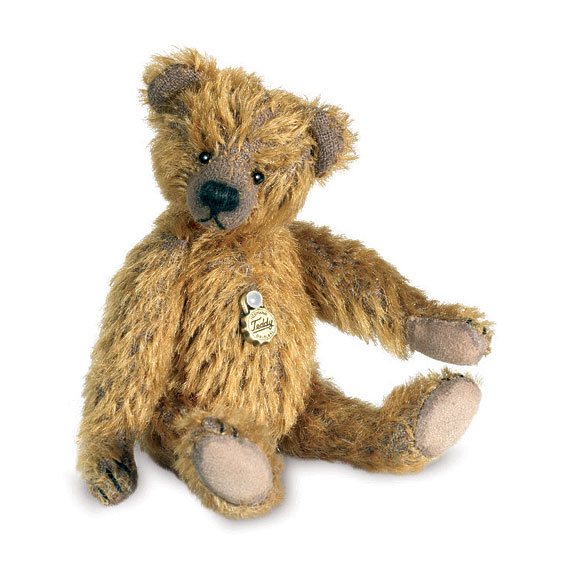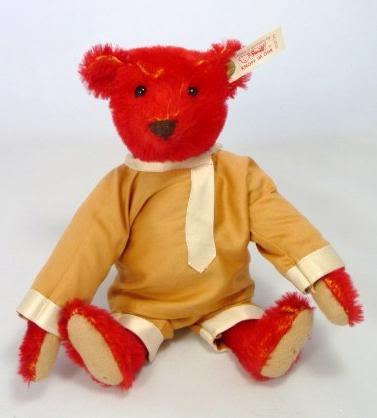Steiff is a German-based plush toy company known for its high quality and equally high prices. It was begun in 1880 by Margarete Steiff, who was later assisted by her brother Fritz.
Margarete Steiff contracted polio as a baby, leaving her wheelchair bound. Finding employment as a seamstress, she started making stuffed animals as a hobby. These toys began as elephants, which were originally a design Steiff found in a magazine and sold as pincushions to her friends. However, children began playing with them, and in the years following she went on to design many other successful animal-themed toys for children, such as dogs, cats and pigs. She designed and made most of the prototypes herself.
The Steiff’s nephew Richard joined in 1897 and gave the company an enormous boost in popularity by creating the teddy bear in 1902. In 1907, Steiff manufactured 974,000 bears, and has been increasing its output ever since.
The Steiff company motto, as styled by Margarete Steiff, is “Only the best is good enough for children”. Steiff products are subject to meticulous testing and inspection. They are required to be highly flame resistant and, among other things, smaller pieces such as eyes must be able to resist considerable tension, wear and tear, etc.
The most common materials used in Steiff toys are alpaca, felt, mohair, and woven plush. Eyes are generally made of wood or glass, and the stuffing is commonly wood shavings or polyester fibers. A large amount of the work is done by hand, from design sketches to airbrushed paint. The final touch on any Steiff toy is the trademark “button in ear” (assuming the animal has one; in any case they’ll find a spot for it).
The famed “button in ear” was devised by Margarete’s nephew Franz in 1904, to keep counterfeits from being passed off as authentic Steiff toys. It is metal and originally had the symbol of an elephant, later replaced by the name “Steiff”. The button is still used to distinguish Steiff toys from fakes. Some special toys have both the elephant and the name.
Margarete Steiff died of pneumonia in Giengen in 1909.
The teddy bear toy was first created in 1902 and was named after the then president of the United States, Theodore Roosevelt. Historians agree the teddy bear got its name when ‘Teddy’ Roosevelt, as the 26th president was nicknamed, was on a hunting trip in Mississippi.
The president failed to make a kill and so his hosts caught a bear, presenting it to him as a target. He refused to shoot it, saying: “Spare the bear”. At the same time Steiff began making a soft plush, jointed bear – with a trademark button in the left ear.
In 1903, the company exported 3,000 bears to America.
Steiff was always the most expensive and is consequently the most valuable now. In fact, the jointed bear is not modelled on the grizzly – but on the barribal bear, a golden bear with long arms and pronounced snout.
Stieff Bears are very collectable and can fetch huge amounts. Everyone has nostalgic memories about their bears!
World’s Most Expensive Teddy Bears

This $2.1 million Steiff’s Louis Vuitton Bear is the most expensive teddy bear ever sold at any auction. The bear was made by a well-known German toy company Steiff. The bear is dress with all Louis Vuitton from head to toe. Jessie Kim of Korea bought this Steiff bear, and now this bear is housed at Teddy Bear Museum in Jeju, Korea.
How are Steiff Teddy bears made?
Manufacturing is much more than just a euphonious term for us.
We have taken up the cause of filing this term with life – according to the tradition and in the spirit of the founder of Steiff, Margarete Steiff.
Because where things are created by hand, there is always alot of creativity, energy, ability, experience, enthusiasm for the little details, dexterity and instinctive feeling at work.
Hand made with lots of love – love of detail and love of the finished product itself.
It is exactly this enthusiasm for the beautiful things in life, the extraordinary, the desire for perfection that you will feel when you hold one of our animals in your hands and stroke its soft fur.
Each of our animals tells his own individual story.
It tells of his soft, comical or even untamed, wild, role models in nature.
It tells his own personal story of his creation from a bold vision, to an initial idea, from his first birthday as a sample animal, of fine materials, precious wool felt and cuddly plush, of finest alpaca and mohair.
It tells of the moment in which it received its unmistakable character – the loving, intricate handicraft with which its realistic-looking eyes are applied and the friendly facial features that are the result when the nose, mouth and claws are stitched by hand.
It seems as if time stands still for just a moment when you meet your new friend by Steiff for the very first time and it smiles at you with a curious, friendly smile.
You might even spontaneously return that smile – because it makes you happy and may even bring back memories you thought had been lost forever.
What are Steiff Teddy bears made from?
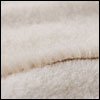 Alpaca – The gold of the Incas
Alpaca – The gold of the Incas
The luxurious wool from the fur of the alpaca is the warmest and thickest natural fibre that exists.
Many years ago, Steiff discovered the exclusive alpaca with its incomparable quality and lasting value for production of wonderful Steiff products as it embodies aesthesia and sensuousness at the same time.
Thanks to natural unsurpassable qualities, Steiff animals and Teddy bears retain their longlasting beauty and with their unique silky-soft tuft, they are always “love at first touch”.
 Mohair – A masterpiece of nature
Mohair – A masterpiece of nature
Silky smooth, lustrous, gentle softness that invites you to touch and feel: all of these are characteristics of mohair. It is a facinating natural fibre obtained from the very long, curly and sumptuous white fur of the angora goat – one of the most valuable races of goats in the world.
A precious and long-lastingly beautiful fibre that has been used since 1901 to make Steiff animals and Teddy bears with wonderfully lustrous, thick and velvety-feeling fur that is a pleasure to both big and small Steiff friends.
A Steiff animal owes its lifelike character to its incomparably real and natural-feeling fur made of woven fur.
This is the result of the unique three-dimensional weaving technique with which the wonderfully soft woven fur is made.
The thread is woven perpendicularly into the cotton backing – thus giving the charming Steiff animals the lifelike animal fur character of their real role models.
It is so delightfully soft that it entices you to cuddle them, stroke them and play with them.
 Plush – Perfect for baby soft skin
Plush – Perfect for baby soft skin
The Steiff baby products use only the finest plush materials and with Steiff, you know your little one will be receiving the softest and most cuddly Teddy bear or animal.
The Steiff plush material is perfect for a baby to snuggle up to and squeeze tightly during bedtime or when your child feels he or she just needs that extra bit of security.
You’ll be safe in the knowledge that all the Steiff plush bears and animals have passed rigorous safety tests meaning you need not worry about harmful substances or skin irritations.
What about toy safety?
“Only the best is good enough for our children”: Over one hundred years ago, the founder of Steiff, Margarete Steiff, was dedicated to doing justice to her personal credo and later Steiff basic principle in all areas of the company.
It is our goal to create not only the most beautiful and best toy animals and Teddy bears in the world but also the safest.
In order to live up to this high standard, we have developed a special quality control system to supervise the entire creative development and production process: from the initial idea for the product until the moment when a Steiff animal leaves the manufactory in Giengen.
We have created the “Steiff Purity Law”.
This involves the voluntary examination of our products – not those imposed by any standards – because harmful substances of any type have absolutely no place in our high-quality Steiff products.
The Steiff Purity Law
- Steiff voluntarily avoids the use of harmful substances – beyond those of legal regulations.
- Steiff avoids the use of all materials which could cause allergies.
- Steiff uses only physiologically-harmless colours for all dyeing and colouring processes.
- Steiff uses only selected materials from renowned manufacturers, mainly from Germany and Europe.
- Steiff uses highest quality, lint-free uppers for its toy animals and Teddy bears.
- Steiff uses only new and safe materials for the fillings of its toy animals and Teddy bears.
- Steiff has clearly higher requirements of the workmanship of seams and applications than required by all international standards.
- Steiff produces toy animals and Teddy bears according to the sustainability principle – they are created to last for generations.
- Steiff is dedicated to observing the highest level of purity during its production process – from cutting the material until the product is delivered to the customer.
- Steiff uses independent laboratories and institutes to consistently examine the Steiff Purity Law.
What is the ‘button in the ear’ and what do the different tags mean?
The Steiff factory was founded in the late 19thC in Giengen, Germany by Margarete Steiff. Steiff showed its first animals with movable limbs at the Leipzig spring trade fair of 1903. One of these was a Teddy bear called 55PB. Here we examine a large Steiff cinnamon mohair teddy bear, with underscored ‘F’ button in ear from c1905.
- The famous Steiff button-in-the-ear was used from 1904. This bear’s underscored ‘F’ button was used from 1905 to 1950.
- His long limbs, large spoon-shaped feet, hump, and shoe-button eyes identify him as a very early Steiff.
- His extremely appealing expression probably contributed to his high value.
- Cinnamon is one of the rarest colours for Steiff bears, along with white. The colour often fades quickly if exposed to light, so good condition examples are rare.
Original Collection
 Every Steiff animal with the world-famous trademark, the Steiff “Button in Ear”, shows that it comes from one of the best families – and every Steiff Teddy bear and Steiff animal proudly wears an ear tag as a clearly recognisable identification.
Every Steiff animal with the world-famous trademark, the Steiff “Button in Ear”, shows that it comes from one of the best families – and every Steiff Teddy bear and Steiff animal proudly wears an ear tag as a clearly recognisable identification.
Both big and small Steiff fans immediately recognise the yellow Steiff ear tag with red writing.
It shows that this is one of the many, wonderful animals and Teddy bears from the wide, unlimited Steiff assortment – an unmistakable original from the famous company with a long-standing tradition.
Limited Edition
 All the animals and Teddy bears at Steiff are very pleased to receive the extraordinary distinction of the white ear tag with red writing because these are produced in a limited edition.
All the animals and Teddy bears at Steiff are very pleased to receive the extraordinary distinction of the white ear tag with red writing because these are produced in a limited edition.
This means that only a limited number are available and some are available only in certain countries.
Each of these limited edition Steiff animals with the white ear tag and the gold-plated “Button in Ear” also brings his new owner a certificate that ensures the authenticity and a special status as a limited edition Steiff animal.
Replica
 The Teddy bears and animals of the replica series by Steiff are a very special and extraordinary species.
The Teddy bears and animals of the replica series by Steiff are a very special and extraordinary species.
This means that these true-to-original animals are reproduced exactly according to their historic role models from the Steiff product history. All Steiff replicas have a white ear tag with black writing to document their special status and the true-to-original “Button in Ear” from the respective year of production. This outstanding distinction lets Steiff friends, fans and collectors know that this is a particularly limited edition Steiff animal with extraordinary, historic character.
How to Identify Steiff Bears
The Steiff bear is the quintessential toy bear collected the world over. The first Steiff bears showed up in the marketplace in 1892 and were the precursor to the beloved teddy bear we know today. Antique Steiff bears are quite collectable, so if you think you have one or are thinking of buying one, it’s a good idea to know some of the basic characteristics of authentic Steiffs before selling or buying one.
Look for the metal button that is pegged into the left ear of each Steiff bear. Steiff began inserting these buttons in 1904. Over the years, the buttons have been made from a few different metals—brass, iron, nickel-plated and, for special limited edition bears, gold-plated. A nickel plated button with no raised lettering on it denotes one of the earliest Steiff bears.
Look for either cloth ear tags or tags sewn into the seam in the chest area. Depending on the tag, look for printing that says such things as “Steiff original,” “Made in Germany” and “Made in US-Zone Germany.” Some tags will have model numbers. Over the years, the tags have been a variety of colours, such as white, red, beige and yellow.
Analyse the material used for the bear’s body. The really old bears were made of mohair. Since 1947, synthetic fibre has been used to construct the bodies.
Check to see what the body is stuffed with. In 1904, they were stuffed with wood-wool, also known as excelsior, which is a kind of slivered wood shaving once used for packing boxes. These Steiff bears also had voice boxes. In 1960, foam rubber and artificial snow flakes started to be used for stuffing. Since 1970, soft synthetic stuffing has been used.
Look at what the eyes are made off. Very old Steiff bears have old shoe button eyes from the Victorian Era. Next came glass eyes around 1910, and since 1960 plastic eyes have been sewn on to the bears.
Examine the pads and claws of the bear. The 1904 bears had felt pads and five claws. In 1906, the five claws were reduced to four per paw. Since 1976, the pads of the bears have been made with jersey knit cloth. There have been no claws added since 1970.
Move the arms and legs of the bear. Steiff bears originally started out with immovable arms and legs, but later, moving joints were designed into the bears. Some of the most charming Steiff bears are those standing on all fours on iron wheels with spokes that allow them to be pulled around or ridden by very small children.
Familiarise yourself with contemporary lines of the Steiff bear. There are limited and unlimited editions, miniatures and plush Steiff bears. Brand new Steiff bears can range in price from £57 all the way up to £780 each.
Tips and warnings
If you already own a Steiff bear, don’t display it in direct sunlight as this can fade the material and reduce the value of the bear as an antique.
Be on guard for counterfeit Steiff bears. If the bear looks too good to be true and the price seems too good of a bargain, be suspicious. Seek out a trusted professional for advice.
Check the bear for insect infestations from time to time. Look for pinholes in the bear’s paw pads. If the bear is made out of mohair and starts losing hair for no reason, you might have insect trouble. If you think the bear is infested, put it in a plastic bag, seal the bag well and put it in the deep freeze for about a day. This should kill the bugs.
Credits:
B. Ellen Von Oostenburg

